The Lines of Torres Vedras were lines of forts and other military defences built in secrecy to defend Lisbon during the Peninsular War. Named after the nearby town of Torres Vedras, they were ordered by Arthur Wellesley, Viscount Wellington, constructed by Colonel Richard Fletcher and his Portuguese workers between November 1809 and September 1810, and used to stop Marshal Masséna's 1810 offensive. The Lines were declared a National Heritage by the Portuguese Government in March 2019.

Mafra is a city and a municipality in the district of Lisbon, on the west coast of Portugal, and part of the urban agglomeration of the Greater Lisbon subregion. The population in 2011 was 76,685, in an area of 291.66 km2.
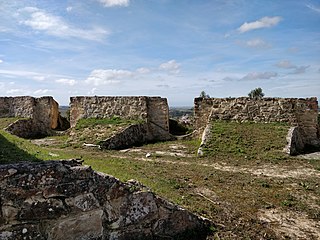
The Battle of Sobral saw an Imperial French army led by Masséna probe the Lines of Torres Vedras, built and defended successfully by Wellington's Anglo-Portuguese Army. Masséna had to order a retreat at the beginning of March 1811 having lost 21,000 men from hunger and disease induced by the scorched earth policy of Wellington.

The Fort of São Julião da Barra is the largest and most complete military defence complex in the Vauban style remaining in Portugal. It is located in São Julião da Barra, on the point of São Gião, in the parish of Oeiras e São Julião da Barra, Paço de Arcos e Caxias, Oeiras Municipality, Lisbon District. Considered in the past as the most important maritime fortification in the country, it had originally, together with the Fort of São Lourenço do Bugio, the role of controlling access to the port of Lisbon. It is currently the official residence of the Portuguese Minister of National Defence.

The Fort of Zambujal, also referred to as the Fort of Casas Velhas, is located near the town of Zambujal-Casas Velhas, in the parish of Carvoeira, municipality of Mafra, Lisbon District, Portugal. Constructed in 1809–10, at 102 metres above sea level, it was one of the forts and other military works built by British and Portuguese troops to protect Lisbon from French forces, forming part of the Second Line of defence of the so-called Lines of Torres Vedras. Each work was given a number and Zambujal was No. 95.
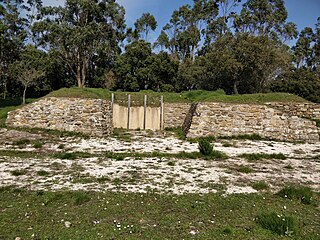
The Fort of Mosqueiro, also known as the Redoubt of Mosqueiro, is one of a group of fortifications in Portugal that made up the Lines of Torres Vedras, which were designed to protect the capital, Lisbon, from possible invasion by French troops during the Peninsular War. It is situated near Bucelas in the Loures municipality in the Lisbon District of Portugal.
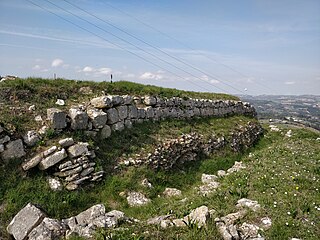
The Fort of Ribas, also known as the Redoubt of Ribas and the Redoubt of Freixial Alto, is one of a group of fortifications in Portugal that made up the second of the three defensive Lines of Torres Vedras, between the Atlantic Ocean and the River Tagus, which were designed to protect the capital, Lisbon, from possible invasion by French troops during the Peninsular War. It was designed for a garrison of 300 soldiers, with three or four cannon. The fort is situated near the town of Bucelas in the Lisbon District of Portugal.

The Fort of São Vicente is located in the town and municipality of Torres Vedras, in the Lisbon District of Portugal. In 1809 it was the first of 152 forts, redoubts and other defences to be developed as part of three defensive lines between the Atlantic Ocean and the River Tagus that were designed by the Duke of Wellington to protect the Portuguese capital, Lisbon, from possible invasion by French troops during the Peninsular War. These came to be known as the Lines of Torres Vedras. Together with the Fort of Alqueidão, it is considered the most important fortress of those constructed for the Lines.
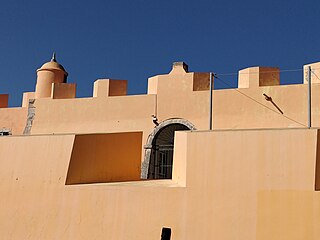
The Fort of São João das Maias, also known as the Fort of Oeiras, is located on the right bank of the River Tagus estuary, in the municipality of Oeiras in the Lisbon District of Portugal. It was constructed between 1644 and 1653. Until 2010 it had been allowed to fall into a state of advanced degradation but in that year it was restored.

The Fort of Casa was the most easterly of the forts and redoubts built in 1809-10 during the Peninsular War on the second line of the three defensive Lines of Torres Vedras aimed at protecting the capital of Portugal, Lisbon. It is situated in the town of Forte da Casa, in the municipality of Vila Franca de Xira, in the Lisbon District.

The Forts of Serra da Aguieira were three forts constructed within 100 metres of each other as part of the second line of defence of the so-called Lines of Torres Vedras, which were constructed by Anglo-Portuguese forces in 1810 in order to protect the Portuguese capital Lisbon from possible invasion by the French during the Peninsular War. The forts are situated in the municipality of Vila Franca de Xira, in the Lisbon District of Portugal. From north to south the three forts are the Fort of Aguieira, the Fort of Portela Grande, and the Fort of Portela Pequena.

The Fort of Arpim is in the parish of Bucelas in the municipality of Loures, in the Lisbon District of Portugal. It was constructed during the Peninsular War, forming part of the first of three defensive Lines of Torres Vedras aimed at protecting Lisbon, the capital of Portugal, from French invasion. The fort, which never saw battle, has been restored and can be visited.

The Fort of Subserra, also known as the Fort of Alhandra, is situated at 142 metres above sea level close to Alhandra in the municipality of Vila Franca de Xira in the Lisbon District of Portugal. Together with other smaller redoubts and batteries that also had the Subserra name, it was built during the Peninsular War (1807–14) as part of the first line of defence of the Lines of Torres Vedras planned by Arthur Wellesley, 1st Duke of Wellington to protect the Portuguese capital of Lisbon and, if necessary, his own retreat.

The Fort of Alqueidão, also known as Forte Grande, is located about 2 kilometres south of the parish of Sobral de Monte Agraço, in the municipality of Sobral de Monte Agraço, in the Lisbon District of Portugal. It was one of the first and one of the largest of 152 military works known as the Lines of Torres Vedras that were built in 1809-10 to defend Lisbon during the Peninsular War (1807–14). The fort played a major role in stopping the advance of Napoleonic troops.

The Forts of Ajuda are located in the parish of Bucelas, in the municipality of Loures in the Lisbon District of Portugal. Just a short distance apart, the Forts of Ajuda Grande (Big) and Ajuda Pequeno (Small) were built in 1810 as part of the Lines of Torres Vedras, which were defensive lines to protect the Portuguese capital Lisbon from invasion by the French during the Peninsular War (1807–14).

Fort Santa Susana, also referred to as Fort São Lourenço, is located south of the beach at São Lourenço, in the parish of Santo Isidoro in the municipality of Mafra within the Lisbon District of Portugal. The fort was built during the Portuguese Restoration War (1640-68), following the instructions of the Council of War set up by King John IV. It was one of many coastal forts designed to protect against both Spanish invasion and pirates. Supervision of the construction was the responsibility of António Luís de Meneses, 1st Marquis of Marialva and 3rd Count of Cantanhede.
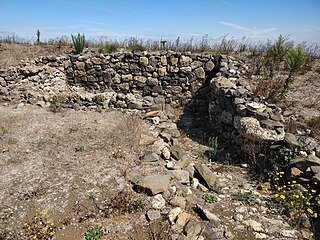
The Fort of Carvalha is located in the parish of São Tiago dos Velhos, at the highest point of the municipality of Arruda dos Vinhos, in the Lisbon District of Portugal. It was built in 1809-10 as part of the first of the three Lines of Torres Vedras, which were defensive lines to protect the Portuguese capital Lisbon from invasion by the French during the Peninsular War (1807–14) or, in the event of defeat, to safely embark a retreating British Army.

The Fort of Cego is located in the municipality of Arruda dos Vinhos, in the Lisbon District of Portugal. It is also known as the Fort of Saint Sebastian. The fort was built in 1809-10 as part of the first of the three Lines of Torres Vedras, which were defensive lines to protect the Portuguese capital Lisbon from invasion by the French during the Peninsular War (1807–14) or, in the event of defeat, to safely embark a retreating British Army.

The Fort of Feiteira is located in the municipality of Torres Vedras, in the Lisbon District of Portugal. Construction of the fort began in 1810 as part of the first of the three Lines of Torres Vedras, which were defensive lines to protect the Portuguese capital Lisbon from invasion by the French during the Peninsular War (1807–14) or, in the event of defeat, to protect the embarkation of a retreating British Army.

The Fort of Archeira is located in the municipality of Torres Vedras, in the Lisbon District of Portugal. It is also today known as the Furadouro Redoubt and was called the “Cheira” at the time of construction. Construction began in 1810 as part of the first of the three Lines of Torres Vedras, which were defensive lines to protect the Portuguese capital Lisbon from invasion by the French during the Peninsular War (1807–14) or, in the event of defeat, to protect the embarkation of a retreating British Army.




















